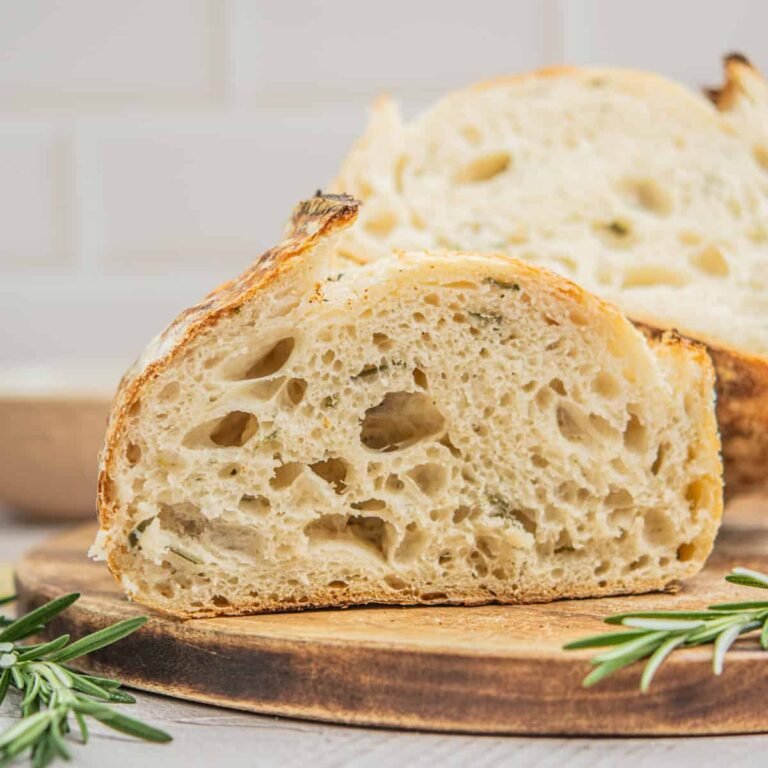This rosemary sourdough bread combines a touch of earthy rosemary and lemon rind to create a beautiful, fragrant bread. Perfect for toasting with soup, cheese or simply butter.
I love the rosemary flavor of sourdough bread. That’s my favorite part of my sourdough Foccia! That’s why I wanted to make bread with a similar taste. It’s beautifully baked and very tasty with a wedge of brie.
Rosemary has a very strong flavor, so it comes a little long. That being said, feel free to increase or decrease the amount to suit your taste.
This rosemary sourdough is
Frabrant aroma and taste – The combination of rosemary, lemon and sourdough is simple, but packed with flavor.
✔Significantly occurred: No commercial yeast is required, just your sourdough starter.
Long fermentation for maximum flavor and texture amasive: overnight cold proof improves texture and taste.
Sourdough starter
This recipe requires an active sourdough starter. I usually make a derivative starter called Levine, especially for my bread. This is part of the starter that is used entirely in the dough. It’s fine to feed the starter to different bait! For best results, use an active, less acidic starter.




Baker’s Schedule
You can fine-tune the timing to suit your schedule, but here is a guide to the timeline I currently use in spring. It changes a little in winter.
9am: Create Les Van. 2pm: Mix the dough from 2pm to 5pm, stretch it for 3 hours, stretch it out and fold it every 30 minutes. 5-7pm: Bulk fermentation lasted another hour or two. 7pm: Form and refrigerate overnight. Next day – Bread can be baked the next morning.


Tools I use
How is it made
Baking
When you’re ready to bake, preheat your Dutch oven. This helps to acquire steam. On the bread, the bread slashes the length of the bread, helping to form ears when baking. The bread is covered for the first 20 minutes, where the bread can be maximized before the crust is set.
After that, once discovered, re-bake until browned to your liking.
Sourdough without a Dutch oven
To bake sourdough without a Dutch oven, preheat the oven with a baking stone or sheet pan. Place the oven safe pan on the bottom rack to create steam. When ready to bake, place the shaped dough on parchment paper and slide it into a hot baking stone or sheet pan. To produce steam, pour hot water into a preheated pot at the bottom of the oven and quickly close the oven door. Bake on steam for 20 minutes, remove the water pan and continue to bake for another 15-20 minutes until the crust is thick and golden.


Tip
Use fresh rosemary – dried rosemary does not give the same flavor. If you use drying, only half of it is used.
✔ Chill overnight – Cold evidence deepens flavor and improves structure.
Steam Bake with Steam – Covered Dutch Oven Trap Steam for better oven springs.
Slicing Let it cool before slices – this prevents the crumbs from turning into gummies.
More sourdough recipes




Rosemary Sourdough Bread
This rosemary sourdough bread combines a touch of earthy rosemary and lemon rind to create a beautiful, fragrant bread. Perfect for toasting with soup, cheese or simply butter.
Levine
twenty five g Sourdough starter50 g All-purpose flour50 g water
material
400 g All-purpose flour With at least 11% protein285 g water1 TBSP Lemon skin I grate it finely1 TBSP Fresh rosemary Chop, decrease, increaseAll Lebanes (Active starter of approximately 100g)8 g salt
Mix the starter ingredients in a bowl and stir well until thoroughly mixed. Add a clean jar and cover it loosely. Place in a warm place until it is doubled.
Once the starter is almost up, combine it with flour and a large mixing bowl. Bring it together using a fork or wooden spoon, then switch to wet hands and mix into a shaggy dough bowl with no remaining dry parts of the flour. Cover the bowl and automate at room temperature until starters are ready.
Add the starter, lemon zest, rosemary and salt to the dough and use wet hands to crush it. Add some slaps and creases to better incorporate it and start developing the structure.
Roll and fold this dough every 30 minutes over the next 3 hours. Pull the dough up and repeat by turning the bowl a quarter. Do this on all sides and always use wet hands.
After folding, place the dough in a clean bowl and give for another hour to finish bulk fermentation. There are clear signs of activity in the dough, such as foam forming, and the dough will sway when you shake the bowl. At room temperature of about 24°C/75°F, my fabric takes another hour or two, but at cold temperatures it takes longer.
Shape the sourdough into butters or bowls, depending on the basket you are using.
Form Bâtard:
Lightly apply flour on the bench and tilt the dough.
Go smoothly into the round and let it rest for 20 minutes.
Flip it over so that the smooth side is on the bottom. Gently stretch it into a rectangle.
Like in the brochure, fold the top third downwards, then raise the bottom third.
Start with the short edge and round it up firmly to the log.
Pull the fabric towards you with a bench to create surface tension.
For final evidence, place the seams on top of the floured springtone.
Cover the dough with a kitchen towel in the fridge for 8-24 hours.
Baking
The next day, preheat the oven and Dutch oven to 450°F/230°C and preheat for at least 30 minutes until high heat.
Remove the hot Dutch oven and flour the bottom well. Remove the dough from the fridge and carefully turn it over from the basket into a Dutch oven. When you bake this in a large pot, it is best to tilt the dough onto parchment paper. This allows you to lower it into the pot.
Use a razor blade or a sharp knife to obtain the fabric.
Bake covered with a lid for about 20 minutes. Remove the lid and bake for an additional 20 minutes depending on your preference and oven. Some ovens can get hot, with less time, or more ovens may be needed.
Allow sourdough to cool for at least 2 hours before slice.
Use fresh rosemary if possible. Dried rosemary does not give the same flavor. If you use drying, only half of it is used.
Serving: 1slicecalorie: 167kcalcarbohydrates: 35gprotein: 5gfat: 0.5gSaturated fat: 0.1gPolyunsaturated fat: 0.2gJanuary Saturated Fat: 0.04gsodium: 313mgpotassium: 51mgfiber: 1gsugar: 0.1gVitamin A: 6iuVitamin C: 1mgcalcium: 9mgiron: 2mg
Sharing is compassionate!


